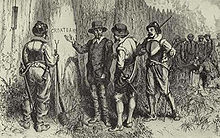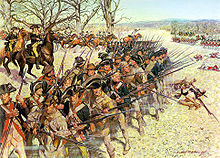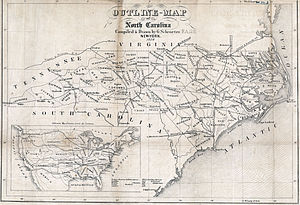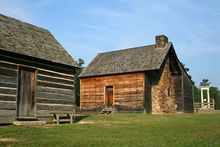North Carolina
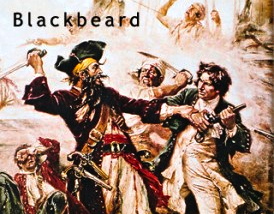
A Dream Deferred: The Lost State of Franklin
“A History Day documentary by Alexander Atallah, senior division. Though my entry to the Colorado History Day competition only made it to the final round, I was happy to have completed a project of this magnitude for the first time. With the help of many historians and helpful reviewers, I conducted my research on the “lost” State of Franklin — Tennessee’s first attempt at statehood, when settlers under the leadership of John Sevier unofficially separated from North Carolina and began a trend of western state-making. The de facto government was a product of the revolutionary mindset of the time, which lasted into the later history of both North Carolina and Tennessee while adversely affecting Native Americans. Overall, I learned a great deal about the larger ideas of the American Revolution and westward expansion through the research and analysis I conducted for my limited 10-minute documentary. National History Day is a truly life-changing project, and if you’re a newcomer to the program, I’d be happy to answer any questions or chat about anything in the link. Enjoy, and let me know what you think! A list of all my movie revisions is located at.” http://gallery.mac.com/alexander.atallah#100182
 Timeline of North Carolina: 1500’s
Timeline of North Carolina: 1500’s
- (1524) Explorer Giovanni da Verrazano explored coastal areas for France
- (1540) Hernando de Soto of Spain explored southwestern part of state searching for gold
- (1584 – 1585) Sir Walter Raleigh sent colonists to establish English settlement on Roanoke Island
- (1586) Hardships forced colonists to leave Roanoke Island, returned to England; Sir Frances Drake dropped off captured African-Caribbean slaves on Roanoke
- (1587) Second colony established at Roanoke by John White; Virginia Dare became first English child born on American soil; White returned to England for supplies
- (1590) White returned to Roanoke, all settlers gone; “CORATOAN” carved into tree
1600’s – 1700’s
- (1663) King Charles II assigned Carolinas territory to eight court favorites, they became “true and absolute Lords Proprietors”
- (1669) Colonial Carolina Fundamental Constitution legalized slavery
- (1705) First town in North Carolina, Bath, was built
- (1712) North Carolina made separate colony; war with Tuscarora Indians began
- (1714) Tuscarora Indians defeated, moved north to join Iroquois
 (1718) Pirate Blackbeard killed off coast
(1718) Pirate Blackbeard killed off coast- (1729) North Carolina became royal English colony
- (1768) Back-country farmers organized Regulator Movement in attempt to reduce excessive taxes
- (1771) Regulators suppressed at Alamance; Gov. Tyron had seven Regulators executed
- (1774) Edenton Tea Party took place (Edenton women protested British rule by putting down their tea cups)
- (1775) Hurricane struck Outer Banks; 165 killed; crops destroyed, mill-dams broken; unsuccessful attempt to instigate a slave revolt (Merrick’s Slave Insurrection)frightened North Carolina slaveholders
- (1776) North Carolina first state to vote for independence; North Carolina’s first American Revolution battle fought at Moores Creek Bridge
- (1789) North Carolina admitted to Union as 12th state; University of North Carolina received charter, first public school in U. S.
- (1794) Capital moved from New Bern to Raleigh
- (1799) First gold nugget in U. S. found at Reed Gold Mine, Cabarrus County
1800’s
- (Early 1800’s) Very little progress made in state, appeared to be asleep, became known as “Rip Van Winkle” state
- (1804) Walton War – dispute between North Carolina and Georgia over 12-mile strip of land in North Carolina
- (1805) Georgia ceded 12-mile strip of land
- (1828) North Carolina native, Andrew Jackson, became 7th president of U.S.
- (1830’s) U.S. government forced Cherokee Indians from homes “Trail of Tears”; many hid in mountains
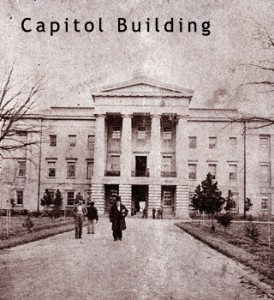 (1831) Workmen fire proofing roof of State Capitol set building on fire; Nat Turner slave insurrection in Virginia caused execution of dozen North Carolina slaves
(1831) Workmen fire proofing roof of State Capitol set building on fire; Nat Turner slave insurrection in Virginia caused execution of dozen North Carolina slaves- (1845) North Carolina native, James Polk, became 11th president of U.S.
- (1851) Antislavery preachers, Adam Crooks, Jesse McBride, run out of state
- (1853) First North Carolina state fair held
- (1861) North Carolina left Union, voted to “undo” the act that had brought it into the United States, rather than secede
- (1861 – 1865) Civil War took place; over 40,000 North Carolinians killed during war
- (1865) Bloodiest battle in North Carolina occurred at Bentonville, Confederates defeated; large number of Confederates surrendered at Bennett Place
- (1866) Tuscarora Indian, Henry Berry Lowrie, led revolt in Robeson County
- (1868) North Carolina readmitted to Union
- (1877) Federal reoccupation troops left state
- (1878) Cherokee reservation formed in western N.C.
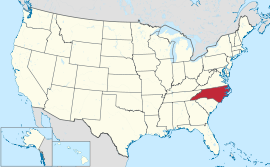 North Carolina (
North Carolina (![]() i/ˌnɔrθ kærəˈlaɪnə/) is a state in the Southeastern United States. The state borders South Carolina and Georgia to the south, Tennessee to the west and Virginia to the north. North Carolina is the 28th most extensive and the 10th most populous of the 50 United States. North Carolina is comprised of 100 counties. Its capital is Raleigh, and its largest city is Charlotte. In the past five decades, North Carolina’s economy has undergone a transition from heavy reliance upon tobacco and furniture making to a more diversified economy with engineering, biotechnology, and finance sectors. North Carolina has a wide range of elevations, from sea level on the coast to 6,684 feet (2,037 m) at Mount Mitchell, the highest point in the Eastern US. The climate of the coastal plains is strongly influenced by the Atlantic Ocean. Most of the state falls in the humid subtropical climate zone. More than 300 miles (500 km) from the coast, the western, mountainous part of the state has a subtropical highland climate. Spanish colonial forces were the first Europeans to make a permanent settlement in the area, when the Juan Pardo-led Expedition built Fort San Juan in 1567.
i/ˌnɔrθ kærəˈlaɪnə/) is a state in the Southeastern United States. The state borders South Carolina and Georgia to the south, Tennessee to the west and Virginia to the north. North Carolina is the 28th most extensive and the 10th most populous of the 50 United States. North Carolina is comprised of 100 counties. Its capital is Raleigh, and its largest city is Charlotte. In the past five decades, North Carolina’s economy has undergone a transition from heavy reliance upon tobacco and furniture making to a more diversified economy with engineering, biotechnology, and finance sectors. North Carolina has a wide range of elevations, from sea level on the coast to 6,684 feet (2,037 m) at Mount Mitchell, the highest point in the Eastern US. The climate of the coastal plains is strongly influenced by the Atlantic Ocean. Most of the state falls in the humid subtropical climate zone. More than 300 miles (500 km) from the coast, the western, mountainous part of the state has a subtropical highland climate. Spanish colonial forces were the first Europeans to make a permanent settlement in the area, when the Juan Pardo-led Expedition built Fort San Juan in 1567.
This was sited at Joara, a Mississippian culture regional chiefdom near present-day Morganton in the western interior. It lasted only 18 months as the natives killed all but one of the 120 men Pardo had stationed at a total of six forts in the area. North Carolina became one of the English Thirteen Colonies, and was originally known as Province of Carolina, along with South Carolina. The northern and southern parts of the original Province separated in 1729. Originally settled by small farmers, sometimes having a few slaves, who were oriented toward subsistence agriculture, the colony lacked cities or even towns. Pirates menaced the seacoast settlements, but by 1718 the pirates had been captured and executed. Growth was strong in the middle of the 18th century, as the economy attracted Scotch-Irish, Quaker, English and German immigrants. The colonists supported the American Revolution, as the Loyalists were weak. North Carolina made the smallest per-capita contribution to the war of any state, as only 7800 men joined the Continental Army under General George Washington; an additional 10,000 served in local militia units under such leaders as General Nathanael Greene. There was some military action, especially in 1780–81. Many Carolinian frontiersmen had moved west over the mountains into the Washington District (later known as Tennessee), but in 1789 the state relinquished its claim to the western lands, ceding them to the national government. After 1800, cotton and tobacco became important export crops, and the eastern half of the state developed a plantation system based on slavery, while the western areas were dominated by white families who operated small farms. In the early national period, the state became a center of Jeffersonian Democracy and Jacksonian Democracy with a strong Whig presence, especially in the West. On May 20, 1861, North Carolina was the last of the Confederate states to declare secession from the Union, 13 days after the Tennessee legislature voted for secession. Some 125,000 North Carolinians saw military service; 20,000 were killed in battle and 21,000 died of disease.
The state government was reluctant to support the demands of the national government in Richmond, and the state was the scene of only small battles. With the end of the war in 1865, the Reconstruction Era began, slavery was abolished without any compensation to the slave-holders, or reparations to the freedmen. A coalition of black Freedmen, northern Carpetbaggers, and local Scalawags controlled state government for three years but the white conservative Democrats had regained power by 1871, in part by violence and physical intimidation at the polls to suppress black voting. In addition to passing laws to impose Jim Crow and legal segregation of public facilities, the state legislature passed a new constitution with provisions that essentially disfranchised most blacks. Exclusion from voting meant they were disqualified to serve on juries or to run for local office; they had no political voice until after the federal Civil Rights Act of 1964 and Voting Rights Act of 1965 were passed to enforce their constitutional rights. A desire to restore white supremacy and angry memories of Reconstruction made the Democratic Party dominant among whites throughout this period of segregation. North Carolina was impoverished by the Civil War, and became increasingly locked into a cotton economy. Towns and cities remained few in the east, but a major industrial base emerged in the late 19th century in the western counties based on cotton mills.
The state was the site of the first successful controlled, powered and sustained heavier-than-air flight, by the Wright brothers, near Kitty Hawkon December 17, 1903. North Carolina was hard hit by the Great Depression, but the New Deal‘s farm programs for cotton and tobacco significantly helped the farmers. After World War II, the state’s economy grew rapidly, highlighted by the growth of such cities as Charlotte, Raleigh, and Durham. In the 1990s, Charlotte became a major regional and national banking center. By the 1960s, changing party politics, passage of civil rights legislation and social changes affected residents’ affiliations. Conservative whites began to vote for Republican national candidates, and gradually for more Republicans on the local level. African Americans have consistently voted for the national Democratic Party, which had begun to enforce their rights in the face of Southern resistance.
Native Americans, lost colonies, and permanent settlement
See also: Native Americans in the United States, Joara, and Roanoke Island
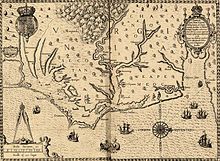 Map of the coast of Virginia and North Carolina, drawn 1585–1586 by Theodor de Bry, based on map by John White of the Roanoke Colony
Map of the coast of Virginia and North Carolina, drawn 1585–1586 by Theodor de Bry, based on map by John White of the Roanoke Colony
North Carolina was inhabited for thousands of years by succeeding cultures of prehistoric native cultures. Before 200 AD, they were building earthwork mounds, which were used for ceremonial and religious purposes. Succeeding peoples, including those of the ancient Mississippian culture established by 1000 AD in the Piedmont, continued to build or add on to such mounds. In the 500–700 years preceding European contact, the Mississippian culture built large, complex cities and maintained far-flung regional trading networks. Historically documented tribes in the North Carolina region included the Carolina Algonquian-speaking tribes of the coastal areas, such as the Chowanoke, Roanoke,Pamlico, Machapunga, Coree, Cape Fear Indians, and others, who were the first encountered by the English; the Iroquoian-speaking Meherrin, Cherokee and Tuscarora of the interior; and Southeastern Siouan tribes, such as the Cheraw, Waxhaw, Saponi,Waccamaw, and Catawba. Spanish explorers traveling inland in the 16th century met the Mississippian culture people at Joara, a regional chiefdom near present-day Morganton. Records of Hernando de Soto attested to his meeting with them in 1540.
In 1567 Captain Juan Pardo led an expedition to claim the area for the Spanish colony, as well as establish another route to protect silver mines in Mexico. Pardo made a winter base at Joara, which he renamed Cuenca. The expedition built Fort San Juan and left 30 men, while Pardo traveled further, and built and staffed five other forts. He returned by a different route to Santa Elena on Parris Island, South Carolina, then a center of Spanish Florida. In the spring of 1568, natives killed all but one of the soldiers and burned the six forts in the interior, including the one at Fort San Juan. Although the Spanish never returned to the interior, this marked the first European attempt at colonization of the interior of what became the United States. A 16th-century journal by Pardo’s scribe Bandera and archaeological findings since 1986 at Joara have confirmed the settlement.
John White returns to find the colony abandoned
In 1584, Elizabeth I, granted a charter to Sir Walter Raleigh, for whom the state capital is named, for land in present-day North Carolina (then Virginia). Raleigh established two colonies on the coast in the late 1580s, both ending in failure. It was the second American territory the English attempted to colonize. The demise of the “Lost Colony” of Roanoke Island, remains one of the mysteries of American history. Virginia Dare, the first English child to be born in North America, was born on Roanoke Island on August 18, 1587. Dare County is named for her. As early as 1650, colonists from the Virginia colony moved into the area of Albemarle Sound. By 1663, King Charles II of England granted a charter to start a new colony on the North American continent which generally established its borders. He named it Carolina in honor of his father Charles I. By 1665, a second charter was issued to attempt to resolve territorial questions. In 1710, due to disputes over governance, the Carolina colony began to split into North Carolina and South Carolina. The latter became a crown colony in 1729. A devastating series of smallpox epidemics swept the South. According to Russell Thornton, “The 1738 epidemic was said to have killed one-half of the Cherokee, with other tribes of the area suffering equally.”
Colonial period and Revolutionary War
See also: Province of Carolina, Province of North Carolina, and American Revolutionary War
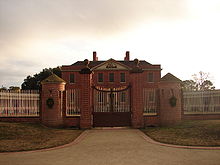 Reconstructed royal governor’s mansion Tryon Palace in New Bern
Reconstructed royal governor’s mansion Tryon Palace in New Bern
The first permanent European settlers of North Carolina after the Spanish in the 16th century were English colonists who migrated south from Virginia, following a rapid growth of the colony and the subsequent shortage of available farmland. Nathaniel Batts was documented as one of the first of these Virginian migrants. He settled south of the Chowan River and east of the Great Dismal Swamp in 1655. By 1663, this northeastern area of the Province of Carolina, known as the Albemarle Settlements, was undergoing full-scale English settlement. During the same period, the English monarch Charles II gave the province to the Lords Proprietors, a group of noblemen who had helped restore Charles to the throne in 1660. The new province of “Carolina” was named in honor and memory of King Charles I (Latin: Carolus). In 1712, North Carolina became a separate colony. Except for the Earl Granville holdings, it became a royal colony seventeen years later.
Differences in the settlement patterns of eastern and western North Carolina, or the low country and uplands, affected the political, economic, and social life of the state from the eighteenth until the 20th century. The Tidewater in eastern North Carolina was settled chiefly by immigrants from rural England and the Scottish Highlands. The upcountry of western North Carolina was settled chiefly by Scots-Irish, English and German Protestants, the so-called “cohee“. Arriving during the mid-to-late 18th century, the Scots-Irish from what is today Northern Ireland were the largest non-English immigrant group before the Revolution and English indentured servants were overwhelmingly the largest immigrant group prior to the Revolution. During the American Revolutionary War, the English and Highland Scots of eastern North Carolina tended to remain loyal to the British Crown, because of longstanding business and personal connections with Great Britain. The English, Welsh, Scots-Irish and German settlers of western North Carolina tended to favor American independence from Britain. Most of the English colonists arrived as indentured servants, hiring themselves out as laborers for a fixed period to pay for their passage.
In the early years the line between indentured servants and African slaves or laborers was fluid. Some Africans were allowed to earn their freedom before slavery became a lifelong status. Most of the free colored families formed in North Carolina before the Revolution were descended from unions or marriages between free white women and enslaved or free African or African-American men. Because the mothers were free, their children were born free. Many had migrated or were descendants of migrants from colonial Virginia. As the flow of indentured laborers to the colony decreased with improving economic conditions in Great Britain, more slaves were imported and the state’s restrictions on slavery hardened. The economy’s growth and prosperity was based on slave labor, devoted first to the production of tobacco. On April 12, 1776, the colony became the first to instruct its delegates to the Continental Congress to vote for independence from the British crown, through the Halifax Resolves passed by the North Carolina Provincial Congress. The dates of both of these events are memorialized on the state flag and state seal.
Throughout the Revolutionary War, fierce guerrilla warfare erupted between bands of pro-independence and pro-British colonists. In some cases the war was also an excuse to settle private grudges and rivalries. A major American victory in the war took place at King’s Mountain along the North Carolina–South Carolina border. On October 7, 1780 a force of 1000 mountain men from western North Carolina (including what is today the State of Tennessee) overwhelmed a force of some 1000 British troops led by Major Patrick Ferguson. Most of the British soldiers in this battle were Carolinians who had remained loyal to the British Crown (they were called “Tories”). The American victory at Kings Mountain gave the advantage to colonists who favored American independence, and it prevented the British Army from recruiting new soldiers from the Tories.
1st Maryland Regiment holding the line at the Battle of Guilford.
The road to Yorktown and America’s independence from Great Britain led through North Carolina. As the British Army moved north from victories in Charleston and Camden, South Carolina, the Southern Division of the Continental Army and local militia prepared to meet them. Following General Daniel Morgan‘s victory over the British Cavalry Commander Banastre Tarleton at the Battle of Cowpens on January 17, 1781, southern commander Nathanael Greene led British Lord Charles Cornwallis across the heartland of North Carolina, and away from Cornwallis’s base of supply in Charleston, South Carolina. This campaign is known as “The Race to the Dan” or “The Race for the River.” In the Battle of Cowan’s Ford, Cornwallis met resistance along the banks of the Catawba River at Cowan’s Ford on February 1, 1781 in an attempt to engage General Morgan’s forces during a tactical withdrawal.
This move to the northern part of the state was to combine with General Greene’s newly recruited forces. Generals Greene and Cornwallis finally met at the Battle of Guilford Courthouse in present-day Greensboro on March 15, 1781. Although the British troops held the field at the end of the battle, their casualties at the hands of the numerically superior American Army were crippling. Following this “Pyrrhic victory“, Cornwallis chose to move to the Virginia coastline to get reinforcements, and to allow the Royal Navy to protect his battered army. This decision would result in Cornwallis’s eventual defeat at Yorktown, Virginia later in 1781. The Patriots’ victory there guaranteed American independence.
Antebellum period
On November 21, 1789, North Carolina became the twelfth state to ratify the Constitution. In 1840, it completed the state capitol building in Raleigh, still standing today. Most of North Carolina’s slave owners and large plantations were located in the eastern portion of the state. Although North Carolina’s plantation system was smaller and less cohesive than those of Virginia, Georgia or South Carolina, significant numbers of planters were concentrated in the counties around the port cities of Wilmington and Edenton, as well as suburban planters around the cities of Raleigh, Charlotte and Durham. Planters owning large estates wielded significant political and socio-economic power in antebellum North Carolina, which was a slave society. They placed their interests above those of the generally non-slave holding “yeoman” farmers of western North Carolina. In mid-century, the state’s rural and commercial areas were connected by the construction of a 129-mile (208 km) wooden plank road, known as a “farmer’s railroad”, from Fayetteville in the east to Bethania (northwest of Winston-Salem).
Map of the roads and railroads of North Carolina, 1854
Besides slaves, there were a number of free people of color in the state. Most were descended from free African Americans who had migrated along with neighbors from Virginia during the 18th century. After the Revolution, Quakersand Mennonites worked to persuade slaveholders to free their slaves. Some were inspired by their efforts and the language of men’s rights, of the Revolution, to arrange for manumission of their slaves. The number of free people of color rose markedly in the first couple of decades after the Revolution. On October 25, 1836 construction began on the Wilmington and Raleigh Railroad to connect the port city of Wilmington with the state capital of Raleigh.
In 1849 the North Carolina Railroad was created by act of the legislature to extend that railroad west to Greensboro, High Point, and Charlotte. During the Civil War, the Wilmington-to-Raleigh stretch of the railroad would be vital to the Confederate war effort; supplies shipped into Wilmington would be moved by rail through Raleigh to the Confederate capital of Richmond, Virginia. During the antebellum period, North Carolina was an overwhelmingly rural state, even by Southern standards. In 1860 only one North Carolina town, the port city of Wilmington, had a population of more than 10,000. Raleigh, the state capital, had barely more than 5,000 residents. While slaveholding was slightly less concentrated than in some Southern states, according to the 1860 census, more than 330,000 people, or 33% of the population of 992,622 were enslaved African Americans. They lived and worked chiefly on plantations in the eastern Tidewater. In addition, 30,463 free people of color lived in the state. They were also concentrated in the eastern coastal plain, especially at port cities such as Wilmington and New Bern, where a variety of jobs were available. Free African Americans were allowed to vote until 1835, when the state revoked their right to vote in restrictions following the slave rebellion of 1831 led by Nat Turner.
American Civil War
Main article: North Carolina in the American Civil War
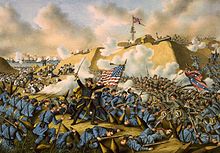 Union captures Fort Fisher, 1865.
Union captures Fort Fisher, 1865.
In 1860, North Carolina was a slave state, in which about one-third of the population of 992,622 were enslaved African Americans. This was a smaller proportion than many Southern states. In addition, the state had just over 30,000 Free Negroes. The state did not vote to join the Confederacy until President Abraham Lincoln called on it to invade its sister-state, South Carolina, becoming the last or second to last state to officially join the Confederacy. The title of “last to join the Confederacy” has been disputed because Tennessee informally seceded on May 7, 1861, making North Carolina the last to secede on May 20, 1861. However, the Tennessee legislature did not formally vote to secede until June 8, 1861. North Carolina was the site of few battles, but it provided at least 125,000 troops to the Confederacy— far more than any other state. Approximately 40,000 of those troops never returned home, dying of disease, battlefield wounds, and starvation. North Carolina also supplied about 15,000 Union troops. Elected in 1862, Governor Zebulon Baird Vance tried to maintain state autonomy against Confederate President Jefferson Davis in Richmond.
Even after secession, some North Carolinians refused to support the Confederacy. Some of the yeomen farmers in the state’s mountains and western Piedmont region remained neutral during the war, while some covertly supported the Union cause during the conflict. Approximately 2,000 North Carolinians from western North Carolina enlisted in the Union Army and fought for the North in the war. Two additional Union Army regiments were raised in the coastal areas of the state that were occupied by Union forces in 1862 and 1863. Confederate troops from all parts of North Carolina served in virtually all the major battles of the Army of Northern Virginia, the Confederacy’s most famous army. The largest battle fought in North Carolina was at Bentonville, which was a futile attempt by Confederate General Joseph Johnston to slow Union General William Tecumseh Sherman‘s advance through the Carolinas in the spring of 1865. In April 1865, after losing the Battle of Morrisville, Johnston surrendered to Sherman at Bennett Place, in what is today Durham. This was the last major Confederate Army to surrender. North Carolina’s port city of Wilmington was the last Confederate port to fall to the Union, in the spring of 1865 after the nearby Second Battle of Fort Fisher.
Bennett Place historic site in Durham, North Carolina.
The first Confederate soldier to be killed in the Civil War was Private Henry Wyatt from North Carolina. He was killed in the Battle of Big Bethel in June 1861. At the Battle of Gettysburg in July 1863, the 26th North Carolina Regiment participated in Pickett/Pettigrew’s Charge and advanced the farthest into the Northern lines of any Confederate regiment. During the Battle of Chickamauga the 58th North Carolina Regiment advanced farther than any other regiment on Snodgrass Hill to push back the remaining Union forces from the battlefield. At Appomattox Court House in Virginia in April 1865, the 75th North Carolina Regiment, a cavalry unit, fired the last shots of the Confederate Army of Northern Virginia in the Civil War. For many years, North Carolinians proudly boasted that they had been “First at Bethel, Farthest at Gettysburg and Chickamauga, and Last at Appomattox.”

